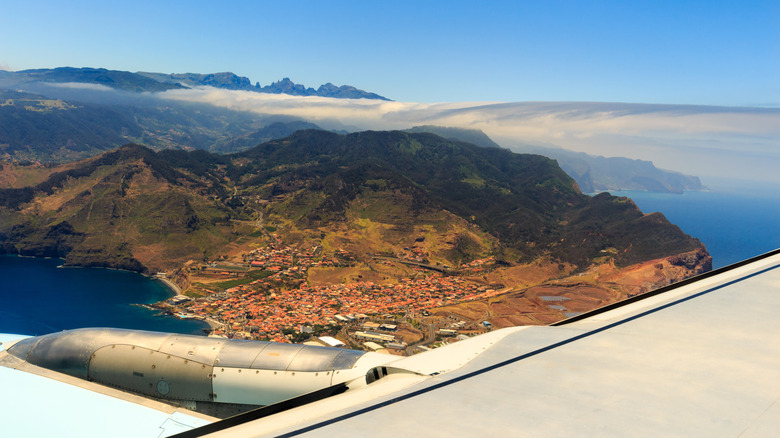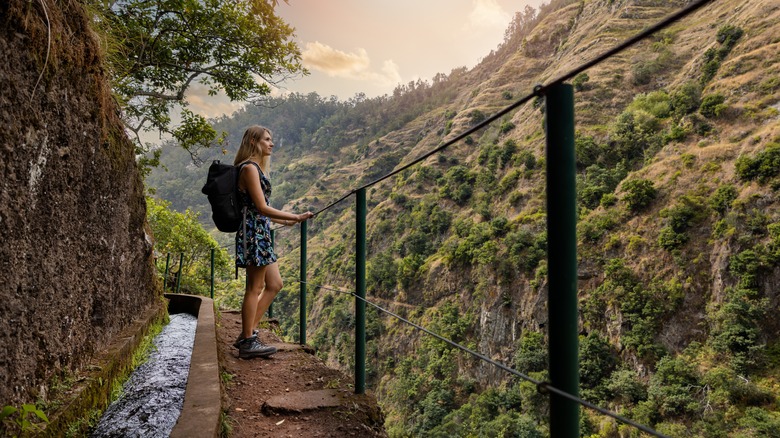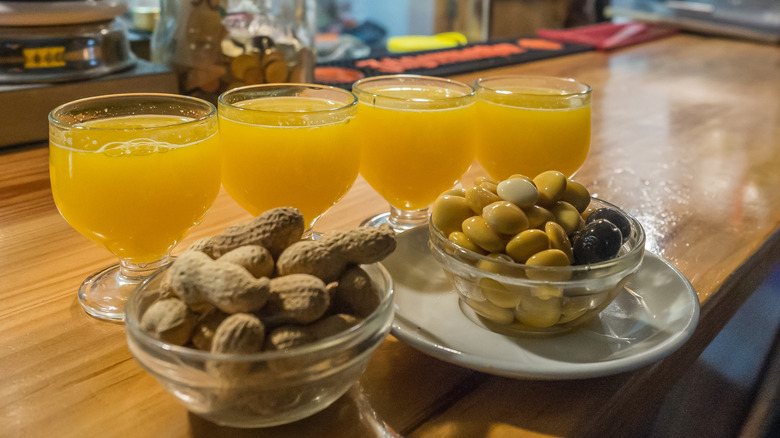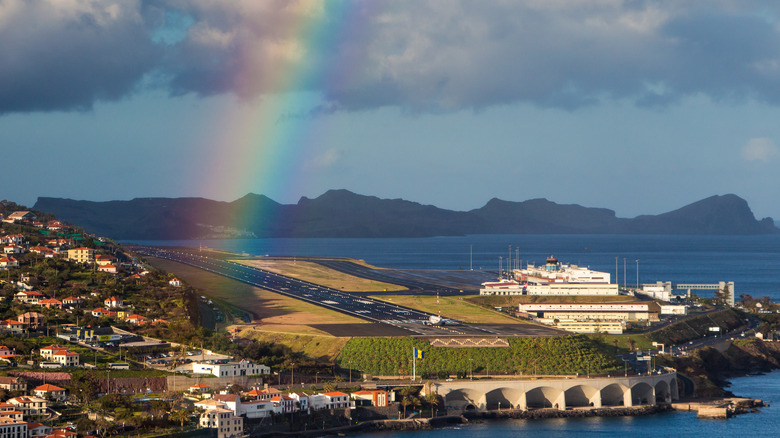Essential Travel Hacks For Your Vacation To Madeira, The Island Known As Europe's Hawaii
Portugal's subtropical isle of Madeira rises from the Atlantic like a greenery-tinted dream. Comprised of the various peaks of massive underwater mountains, Madeira has a coastline stretching some 90 miles, with the vast majority of it backed by diagonal slopes or sheer cliffs. But despite this dramatic landscape, Madeira features all the conveniences of Europe's modern infrastructure, tucked amid vast tracts of verdant wilderness clinging to steep volcanic hillsides.
A vacation to Madeira can be equally adventurous and luxurious, with a wide range of attractions to explore. For these reasons and more, this lush archipelago is often considered as Europe's version of Hawaii — except that Madeira is less crowded than Maui but equally stunning. However, traveling to and around Madeira is not always easy, as its remote location and unique geography present special challenges that are best planned for in advance.
Whether seeking easygoing days of sunbathing by resort pools or hardcore hiking excursions amid pristine mountaintop forests, Madeira has plenty to offer. Furthermore, the unique characteristics of this isolated isle can provide especially memorable encounters with local culture and history, if you know where to look. Based on varied experiences from an amazing weeklong Madeira journey that included road-tripping all over the island, this article will provide plenty of hacks to ensure that your time visiting "the pearl of the Atlantic" is optimally enjoyable.
Visit Madeira and a mainland European city in the same trip
While it's possible to fly directly from North America to Madeira, options are limited. Azores Airlines — based in Portugal's larger mid-Atlantic archipelago — provides direct flights to Madeira's capital city of Funchal from New York, Boston, and Toronto, although some of these schedules aren't offered year-round. Meanwhile, trips from the U.S. to Funchal aboard Air Portugal require a stopover in Lisbon, while other transatlantic flights to Madeira also involve at least one layover in mainland Europe. This means that your journey can easily take over 24 hours of travel time each way, adding stressful ordeals to the beginning and end of what should be a relaxing vacation.
For more flexibility in your choice of departure city — and the opportunity to enjoy additional travel experiences while taking a more leisurely pace en route to Madeira — consider planning your trip in stages to include visiting an air hub city like London, Amsterdam, Paris, Berlin, or Vienna. The airports of these cities and others across Europe offer direct flights to Funchal, often aboard low-cost carriers like RyanAir, EasyJet, and WizzAir. If you find a bargain-priced ticket to a mainland European city that you've wanted to visit anyway, this jet-setting strategy could end up saving you money on airfare. After a few days in your arrival city, hop over to Madeira on a round-trip, low-cost airline ticket, and on the way back spend another couple days in your original destination before returning Stateside.
Prepare for a lot of cardio
Madeira's striking slopes are picturesque — but they've been problematic for visitors ever since Portuguese explorers first discovered this previously uninhabited island in the early 1400s. The scarcity of flat terrain across Madeira forced settlers to carve tiny patches of farmland into the sides of steep hills, and these fertile terraces remain in use today to provide locally grown produce. Even now, working these farms where no tractor can go still requires the backbreaking manual labor of locals.
While Madeira vacationers don't have it that rough, before visiting the island make sure you're prepared to climb a fair share of hills and stairs. The waterfront areas of Funchal are generally flat, but a little further inland the city soon spreads up inclines that make some of San Francisco's most notorious hills seem like gradual grades. Even walking down some of Funchal's steepest streets can be a challenge, which is why descending in fast-sliding wicker toboggans ranks among Madeira's most iconic (and active) attractions.
If you're a natural mountaineer, you'll be right at home — pack your best gear for taking hikes on vacation, and get ready to explore some incredible (and incredibly difficult) trails islandwide. However, if you're out of shape and have any plans to explore Madeira beyond the hotel bar, consider building up your leg muscles and stamina during the weeks before your trip. Also, bring comfy shoes with soles that can grip cobblestones when you're walking uphill or heading back down.
If renting a car, book far in advance or be ready to drive a stick
It's absolutely worthwhile to explore Madeira beyond Funchal. The island's beauty is abundant in many other coastal communities, from the northernmost town of Porto Moniz — blessed with natural oceanfront pools of volcanic stone — to the sun-drenched southern shoreline of Ponta do Sol. Meanwhile, breathtaking inland summits like Pico do Arieiro afford far-reaching vistas above the clouds. Guided tours take visitors to Madeira's major sightseeing spots, and public buses operate islandwide ... but renting a car is the best way to access all of these spots and many more.
However, difficult as walking can be on Madeira's vertigo-inducing inclines, driving around the island entails even more challenges. Switchbacks and slender hilly roads hide hairpin turns where oncoming cars suddenly appear out of nowhere. It's also not easy to navigate villages that are essentially carved into cliffs, and Funchal features big-city traffic with added aspects of gradient gravity.
Make sure to learn the best ways to choose a good car rental company in Europe before booking your wheels in Madeira, and answer the important question: Can you handle a stick shift? Many rental cars in Madeira (and the rest of Europe) have manual transmissions, and if you're only experienced at driving an automatic, this island's angled roads are a bad place to practice your skills with a clutch pedal. Unless you're truly confident about driving a stick, reserve a car with an automatic transmission far in advance.
Visit during the off-season, but be ready for rainy days
For a European destination of rugged beauty and contemporary conveniences that boasts springtime weather year-round, Madeira is surprisingly affordable. Daily costs are considerably less than what it typically takes to enjoy many U.S.-based tourism hotspots (let alone pricier parts of Europe, like Scandinavia or Switzerland), so Madeira definitely belongs on the list of gorgeous islands for vacationing that won't break the bank. While accommodations, restaurant meals, and entrance fees for many attractions aren't remarkably cheap, they're consistently reasonable — and you can maximize Madeira's value for money even more by visiting during the off-season.
While this hack isn't exclusive to Madeira, the island's mild temperatures make it especially applicable. The average daily temperature during the coldest months of January and February is around 65 degrees Fahrenheit, while the hottest averages of August are generally about 80. However, mid-summer also brings the highest numbers of visitors, so to enjoy the island's charms in balmy weather but among fewer people, it's best to visit from autumn through spring. The diminished visitor numbers are also likely to coincide with reduced hotel rates.
But one important caveat — while temperatures stay fairly steady year-round, summertime visitors see the least rain. Sunshine is still abundant during winter, but precipitation averages are highest from October through January, so be prepared for occasional downpours, especially on the island's north shore. On the plus side, indoor attractions shouldn't be too crowded at that time of year.
For sandy beach time, head to Porto Santo
Although Madeira has a plethora of eye-catching coastal scenery, if you're looking for long, sandy beaches, this is not the island for you. Most of Madeira's shoreline is rocky and pebbly, and some of its powdery beaches — like at the eastern town of Machico or the southern resort zone of Calheta — are composed of imported sands from the Moroccan desert. What's more, to keep these precious grains from being swept away by strong Atlantic waves, huge stone jetties were constructed that block views of the ocean horizon, curtailing the cherished beachgoer experience of watching for boats passing by in the distance.
Thankfully, Madeira's little sister island of Porto Santo features a natural golden-sand beach spanning over five miles, perfect for swimming, sunbathing, and strolling with a loved one. From Madeira, it takes only a 15-minute flight or a ferryboat ride lasting less than three hours to reach Porto Santo, where cerulean waters lap the sandy shore between intriguing rock formations, while windsurfers and sailboats offer gliding visual diversions. What's the catch? Porto Santo is a fraction of Madeira's size, with a much smaller population and much less to do, although active attractions include a golf course and scuba diving. Regardless, Porto Santo is a perfect destination for folks eager to leave the world behind and feel sand between their toes for days on end, with no stone walls confining their daydreamy gaze over crashing waves.
Keep an eye on Funchal's cruise port
The historic heart of Madeira's capital offers many monumental highlights, from the 500-year-old Funchal Cathedral to the Mercado dos Lavradores, a permanent farmers market brimming with island-grown fruits and vegetables. From Funchal's waterfront, a cable car whisks passengers uphill to the city's lofty Monte district, where attractions include a fairytale palace surrounded by ornate tropical gardens and the Baroque-styled Ingreja de Nossa Senhora church, providing a sweeping panorama over the entire city and ocean beyond from its sprawling hilltop plaza. What do all these places have in common? They become packed with tourists whenever cruise ships fill Funchal's port.
Since Madeira was first settled, Funchal's port serves as the island's primary disembarkation point for docking vessels, and these days it's estimated that over a half-million cruise ship passengers arrive annually. The harbor can accommodate multiple skyscraper-sized pleasure boats at once, and when that happens, the city's star attractions can quickly be overwhelmed by seagoing sightseers, who may only have a few hours to hurriedly see as much of Madeira's capital as they can. If you're staying in Funchal for a few days, it pays to check online cruise-tracking sources and find out in advance when the port will be hosting a fleet of massive floating resorts. Unless you enjoy crowds and long lines, avoid Funchal's main attractions during that time — instead, enjoy a lazy afternoon lounging by the hotel pool, or seek out some of the city's more obscure museums.
Plan logistics for levada walks carefully
Madeira's north side gets more rainfall than the southern shore, so centuries ago settlers started constructing an intricate network of slender stone aqueducts carrying water to the drier regions. This system is still vital to island life today. Called levadas, these channels twist for miles through Madeira's inland mountains and thick vegetation. Beyond providing potable water and irrigation for farms, levadas also serve as waterfall-lined pathways for astoundingly beautiful walks through otherwise inaccessible wilderness areas.
A levada walk is a quintessential Madeira activity, and plenty of tour agencies offer group excursions including transportation to trailheads and then back into civilization from set pickup points. However, it's certainly possible to embark on independent levada adventures — if you plan the logistics for them carefully. Many of the best-known walks begin far from Funchal, and take hikers to destinations quite distant from where they began, so it's generally not practical to explore levadas by rental car unless you're willing to backtrack to your parking place.
One budget-friendly option is taking a public bus to a levada walk starting point, and then catching another bus back into town after completing your excursion; this is even possible just outside of Funchal. But to experience Madeira's levadas alongside some of the isle's most pristine terrain, visit a nature reserve that features these stone-hewn sluiceways. In the hills above the north shore town of Santana, the Queimadas Forest Park is a misty sanctuary where easy walking trails are bordered by lovely levadas.
Ask your server to ensure your seafood is local
As befits its location amid the Atlantic Ocean, Madeira is a promised land for seafood lovers — and since fish has long been a staple here, several specialties of Poseidon's delights are unique to the island. Despite the disturbing appearance of the black scabbardfish caught deep in Madeira's surrounding waters, chefs transform it into a succulent dish called espada, topped with island-grown bananas and passionfruit sauce. Other genuine Madeiran seafood delicacies include limpets grilled within their shells and slathered with garlic butter, as well as seared tuna steaks flavored with a marinade of vinegar and white wine infused with garlic, bay leaves, and salt.
Though Madeirans are never far from the ocean, that doesn't mean all of their seafood was harvested nearby. Bacalhau, the Portuguese specialty of salted cod, is a major reason why Lisbon is one of the best foodie destinations in Europe, and it's popular in Madeira as well — but many tons of the codfish that it's made from are actually imported from Norway. Different octopus dishes also grace many menus in Funchal, but this isn't a traditional seafood treat of Madeira either, and there's no guarantee that the tentacle on your plate originated from the shoreline visible from your table. So, to make sure that the seafood you order is as fresh as can be, don't hesitate to ask restaurant servers about the source of any fish dish, and if they might recommend a local catch of the day.
For truly quiet nights, stay outside of Funchal
Madeira is not a nightlife hotspot. If you're expecting an island full of thumping clubs where multicolored lasers shine toward the stars and revelers mingle on the shoreline till dawn, this vacation will be a disappointment. But for many visitors, Madeira's relative tranquility provides exactly what they're looking for.
Funchal does feature a fair number of after-hours hangouts, but many of these are small bars with a few sidewalk tables where locals gather for spirited conversations, which may occasionally combine in a cacophony that drowns out the sound of nearby crashing waves. In the city's historic Zona Velha — once a grungy neighborhood of fishermen, now a hip hub of restaurants and artwork — you might pass an eatery where the sonorously melancholy songs of Portuguese fado music are performed live during dinner. And if you're really eager to visit a full-scale nightclub with a dance floor and rooftop terrace, well, that is still an option.
However, if you're quite certain that quietude is what you want during your Madeira vacation, consider staying in some of the other communities beyond Funchal. While the neighboring isle of Porto Santo offers some buzzing beach bars during summertime, and pretty much every Madeiran town has at least a couple of welcoming watering holes, you can expect peaceful evenings in coastal hideaways like Ribeira Brava and Porto da Cruz. Municipalities like these still offer stunning oceanfront scenery and historic landmarks, along with moonlit sensations of divine isolation.
Drink your first few poncha cocktails while standing
Poncha is Madeira's iconic cocktail, with a long history unique to the isle's culture and crops. Initially concocted for fishermen to boost their immune systems, this drink's earliest incarnation was a blend of pulpy lemon juice, honey, and rum distilled from Madeiran sugarcane. Later the honey was sometimes replaced with more sugar, and over time new versions of the drink were created with different juices from other island-grown fruits — like tangerines, passion fruit, and tamarillo — though the original recipe remains popular to this day.
While premade poncha is available at souvenir shops around the island, imbibing this customary cocktail from the bottle is a poor substitute for the experience of enjoying it fresh. Bars across Madeira specialize in whipping up this traditional tipple, constantly muddling varied fruits to produce multicolored juices that are blended with the local rum, called aguardente de cana. Poncha is typically served alongside a handful of peanuts or pickled lupin beans — salty snacks that pleasantly offset the drink's zesty sweetness.
One of the best places to enjoy this drink in Funchal is Rei da Poncha, found next to a small cobblestone square filled with tables that are rarely unoccupied ... but this lack of seating can be a blessing in disguise. You see, the refreshing fruitiness of poncha masks the strength of this drink, and it's easy to overindulge. Test your tolerance by sipping your first few ponchas while standing at the bar, or you might find yourself struggling to get up from a stool.
Set time aside for possible flight delays
Located just outside of Funchal, Madeira's main airport is named after Cristiano Ronaldo, the island-born soccer superstar. While this Portuguese athlete is a living legend of his sport, over the years Ronaldo obtained a reputation for being temperamental — and conditions can be equally unpredictable at the airport dubbed in his honor. With the airport's single runway being exposed to the open Atlantic on one side and walled in by tall slopes on the other, inclement weather and storms often cause Madeira flights to take much longer than expected.
Carved into a hillside, this runway is a high achievement of modern engineering. To extend far enough to accommodate modern jets, a long segment of the tarmac is built on huge concrete stilts. Nonetheless, because of the strong windshear that frequently buffets arriving planes, landings are regularly aborted at the last moment — and when conditions are severe, flights must be redirected to other airports at not-so-nearby destinations like Lisbon or the Canary Islands.
So, be prepared for your flight to experience delays if blustery conditions are passing through Madeira, both when arriving or departing. Pilots are trained specifically to prepare for this infamous runway, so if your flight is diverted or grounded, it's almost certainly for a very good reason. If you're stranded at the terminal for a few hours, try to stay calm and look on the bright side — you may end up spending an extra night on the island at a resort hotel for no charge.











